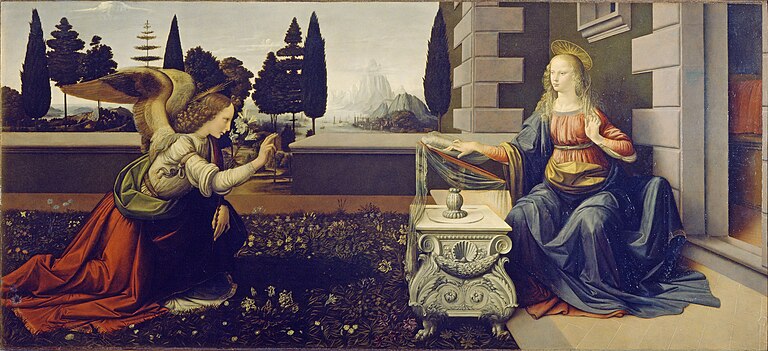
Back Jibril ACE Gabriël Afrikaans ገብርኤል (መልዐክ) Amharic جبرائيل Arabic ܓܒܪܐܝܠ (ܡܠܐܟܐ) ARC جبرائيل ARZ জিব্ৰাইল Assamese Arcánxel Gabriel AST Cəbrayıl (arxangel) Azerbaijani جبرئیل AZB
Gabriel | |
|---|---|
Detail of Gabriel from the Annunciation by Leonardo da Vinci (1470s) | |
| Archangel, Angel of Revelation, Commander of the Powers | |
| Venerated in |
|
| Feast |
|
| Attributes | Carrying a lily,[1] a trumpet,[citation needed] a shining lantern,[citation needed] a branch from Paradise,[citation needed] a scroll,[1] and a scepter.[1] |
| Patronage | Telecommunication workers,[2][3] radio broadcasters,[3] messengers,[3] postal workers,[3] clerics,[3] diplomats,[3] stamp collectors,[3] Portugal, Santander, Cebu, ambassadors |
In the Abrahamic religions (Judaism, Christianity, Islam and the Baháʼí Faith), Gabriel (/ˈɡeɪbriəl/ GAY-bree-əl)[N 2] is an archangel with the power to announce God's will to mankind. He is mentioned in the Hebrew Bible, the New Testament, the Quran and the Kitáb-i-Aqdas. Many Christian traditions – including Eastern Orthodoxy, Catholicism, Lutheranism, and Anglicanism – revere Gabriel as a saint.[4][5][6][7]
In the Hebrew Bible, Gabriel appears to the prophet Daniel to explain his visions (Daniel 8:15–26, 9:21–27). The archangel also appears in the Book of Enoch and other ancient Jewish writings not preserved in Hebrew. Alongside the archangel Michael, Gabriel is described as the guardian angel of Israel, defending its people against the angels of the other nations.
In the New Testament, the Gospel of Luke relates the Annunciation, in which the angel Gabriel appears to Zechariah foretelling the birth of John the Baptist with the angel Gabriel foretelling the Virgin Mary the birth of Jesus Christ, respectively (Luke 1:11–38).
Islam regards Gabriel as an archangel sent by God to various prophets, including Muhammad.[8] The first five verses of the Al-Alaq, the 96th chapter of the Quran, are believed by Muslims to have been the first verses revealed by Gabriel to Muhammad.[8]
Cite error: There are <ref group=N> tags on this page, but the references will not show without a {{reflist|group=N}} template (see the help page).
- ^ a b c Ronner, John (March 1993). Know Your Angels: The Angel Almanac with Biographies of 100 Prominent Angels in Legend & Folklore-and Much More!. Murfreesboro, TN: Mamre Press. pp. 70–72, 73. ISBN 9780932945402. LCCN 93020336. OCLC 27726648. Retrieved 15 November 2013.
Artists like to show Gabriel carrying a lily, a scroll and a scepter.
- ^ Catholic Online. "St. Gabriel, the Archangel". Catholic.org. Retrieved 15 November 2013.
- ^ a b c d e f g Cite error: The named reference
Guiley2004p140was invoked but never defined (see the help page). - ^ Zimmerman, Julie. "Friar Jack's Catechism Quiz: Test Your Knowledge on Angels". AmericanCatholic.org. Archived from the original on 21 May 2012. Retrieved 16 February 2012.
- ^ Blersch, Jeffrey (21 September 2019). "St. Michael and All Angels". Pacific Hills Lutheran Church. Archived from the original on 1 February 2023. Retrieved 4 May 2023.
- ^ For example, Book of Common Prayer 1662, Calendar (29 September) "S. Michael and all Angels", page xxix; or propers, page 227, "Saint Michael and All Angels".
- ^ Aranda Perez, Gonzalo. "Gabriel, Archangel". The Claremont Colleges Digital Library. The Coptic Encyclopedia, volume 4. Retrieved 22 April 2024.
- ^ a b Cite error: The named reference
EoQwas invoked but never defined (see the help page).
© MMXXIII Rich X Search. We shall prevail. All rights reserved. Rich X Search
